
‘Sri Chaitanya Mahaprabhu: His Life and Precepts.’
by Srila Bhaktivinod Thakura:
“This account originally appeared in a short work by Srila Bhaktivinoda Thakura entitled, ‘Sri Caitanya Mahaprabhu: His Life and Precepts.'(dated 20th August 1896.)”
This was taken from “Prologue” to “Teachings of Lord Caitanya”(A. C. Bhaktivedanta Swami Prabhupada. 1974. pages xiii-xxii.)
Who better could we find to include here than the pure unalloyed devotee, and foremost scholar in Vaisnava circles Srila Bhaktivinoda Thakura to perform this task.
He starts his essay; “Caitanya Mahaprabhu was born in Mayapur in the town of Nadia just after sunset on the evening of the 23rd Phalguna (1407 Sakadba), answering to the 18th of February 1486 of the Christian Era. The moon was eclipsed at the time of His birth, and the people of Nadia were then engaged, as was usual on such occasions, in bathing in the Bhagirathi with loud cheers of Haribol. His father, Jagannatha Misra, a poor ‘brahmana’ of the Vedic order, and His mother, Saci-devi, a model good woman, both descended from ‘brahmana’ stock originally residing in Sylhet. Mahaprabhu was a beautiful child, and the ladies of the town came to see Him with presents. His mother’s father, Pandita Nilambara Cakravarti, a renowned astrologer, foretold that the child would be a great personage in time; and he, therefore, gave him the name Visvambhara. The ladies of the neighbourhood styled him Gaurahari on account of His golden complexion, and His mother called Him Nimai on account of the ‘nimba’ tree near which He was born. Beautiful as the lad was, everyone heartily loved to see Him every day. As He grew up He became a whimsical and frolicsome lad. After His fifth year, He was admitted into a pathasala where He picked up Bengali in a very short time.
“Most of His contemporary biographers have mentioned certain anecdotes regarding Caitanya which are simple records of His early miracles. It is said that when He was an infant in His mother’s arms He wept continually, and when the neighbouring ladies cried ‘Haribol’ He used to stop. Thus there was a continuation of utterance of ‘Haribol’ in the house, foreshewing the future mission of the hero. It has also been stated that when His mother gave Him sweetmeats to eat, He ate clay instead of the food. His mother, asking for the reason, He stated that as every sweetmeat was nothing but clay transformed, He could eat clay as well. His mother, who was also the consort of a ‘pandita’, explained that every article in a special state was adapted to a special use. Earth, while in the state of a jug, could be used as a water pot, but in the state of a brick such a use was not possible. Clay, therefore in the form of sweetmeats was usable as food, but clay in its other states was not. The lad was convinced and admitted His stupidity in eating clay and agreed to avoid the mistake in the future. Another miraculous act has been related.
It is said that a brahmana on pilgrimage became a guest in His house, cooked food and read grace with meditation upon Krsna. In the meantime the lad came and ate up the cooked rice. The ‘brahmana’, astonished at the lad’s act, cooked again at the request of Jagannatha Misra. The lad again ate up the cooked rice while the ‘brahmana’ was offering the rice to Krsna with meditation. The ‘brahmana’ was persuaded to cook for the third time. This time all the inmates of the house had fallen asleep, and so the lad showed Himself as Krsna to the traveller and blessed him. The ‘brahmana’ was then lost in ecstasy at the appearance of the object of his worship. It has also been stated that two thieves stole away the lad from His father’s door with a view to purloin His jewels and gave Him sweetmeats on the way. The lad exercised His illusory energy and deceived the thieves back towards His own house. The thieves, for fear of detection, left the boy there and fled. Another miraculous act that has been described is the lad’s demanding and getting from Hiranya and Jagadisa all the offerings they had collected for worshiping Krsna on the day of Ekadasi. When only four years of age He sat on rejected cooking pots which were considered unholy by His mother. He explained to His mother that there was no question of holiness and unholiness as regards to earthen pots thrown away after the cooking was over. These anecdotes relate to His tender age up to the fifth year.
“In His eighth year, He was admitted into the tola of Gangadasa Pandita in Ganganagara close by the village of Mayapur. In two years He became well read in Sanskrit grammar and rhetoric. His readings after that were of the nature of self-study in His own house, where He had found all-important books belonging to His father, who was a ‘pandita’ himself. It appears that He read the ‘smrti’ in His own study, and the ‘nyaya’ also, in competition with His friends, who were then studying under the celebrated ‘pandita’ Raghunatha Siromani. “Now, after the tenth year of His age, Caitanya became a passable scholar in grammar, rhetoric, the ‘smrti’ and the ‘nyaya’. It was after this that his elder brother Visvarupa left his house and accepted the ‘ashrama’ (status) of a ‘sannyasi’ (ascetic). Caitanya, though a very young boy, consoled His parents, saying that He would serve them with a view to please God. Just after that, His father left this world. His mother was exceedingly sorry, and Mahaprabhu, with His usual contented appearance, consoled His widowed mother.
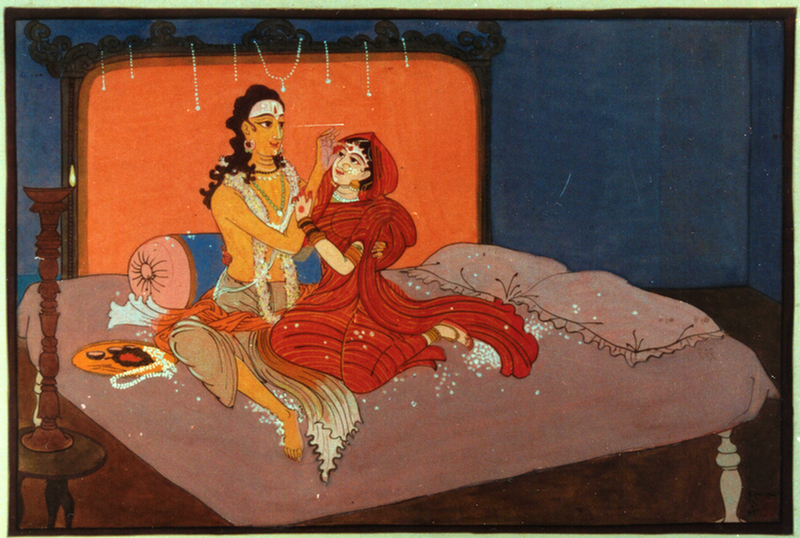
It was at the age of 14 or 15 that Mahaprabhu was married to Laksmidevi, the daughter of Vallabhacarya, also of Nadia. He was at this age considered one of the best scholars of Nadia, then renowned seat of ‘nyaya’ philosophy and Sanskrit learning. Not to speak of the ‘smarta panditas’, the ‘Naiyayikas’ were all afraid of confronting Him in literary discussions. Being a married man, He went to Eastern Bengal on the banks of the Padma for acquirement of wealth. There He displayed His learning and obtained a good sum of money. It was at this time that He preached Vaisnavism at intervals. After teaching him the principles of Vaisnavism, He ordered Tapanamisra to go to and live in Benares. During His residence in East Bengal, His wife Laksmidevi left this world from the effects of snake bite. On returning home, He found His mother in a mourning state. He consoled her with a lecture on the uncertainty of human affairs. It was at His mother’s request that He married Visnupriya, the daughter of Raja Pandita Sanatana Misra. His comrades joined Him on His return from pravasa or sojourn. He was now so renowned that He was considered to be the best pandita in Nadia. Kesava Misra of Kashmir, who had called himself the Great Digvijayi, came to Nadia with a view to discuss with the ‘pandita’ of that place. Afraid of the so-called conquering pandita, the tola professors of Nadia left their town on pretence of invitation. Kesava met Mahaprabhu at the Barokona-ghata in Mayapur, and after a very short discussion with Him he was defeated by the boy, and mortification obliged him to decamp. Nimai Pandita was now the most important ‘pandita’ of His times.
“It was at the age of 16 or 17 that He travelled to Gaya with a host of His students and there took His spiritual initiation from Isvara Puri, a Vaisnava ‘sannyasi’ and a disciple of the renowned Madhavendra Puri. Upon His return to Nadia, Nimai Pandita turned religious preacher, and His religious nature became so strongly represented that Advaita Prabhu, Srivasa and others who had before the birth of Caitanya already accepted the Vaisnava faith were astonished at the change of the young man. He was then no more a contending ‘naiyayika’, a wrangling ‘smarta’ and a criticizing rhetorician. He swooned at the name of Krsna and behaved as an inspired man under the influence of His religious sentiment. It has been described by Murari Gupta, an eye-witness, that He showed His heavenly powers in the house of Srivasa Pandita in the presence of hundreds of His followers, who were mostly well-read scholars. It was at this time that He opened a nocturnal school of ‘kirtana’ in the compound of Srivasa Pandita with His sincere followers. There He preached, there He sang, there He danced, and there He expressed all sorts of religious feelings. Nityananda Prabhu, who was then a preacher of Vaisnavism and who had then completed His travels all over India, joined Him at that time. In fact, a host of ‘pandita’ preachers of Vaisnavism, all sincere at heart, came and joined Him from different parts of Bengal. Nadia now became the regular seat of a host of Vaisnava ‘acaryas’ whose mission it was to spiritualize mankind with the highest influence of the Vaisnava creed.
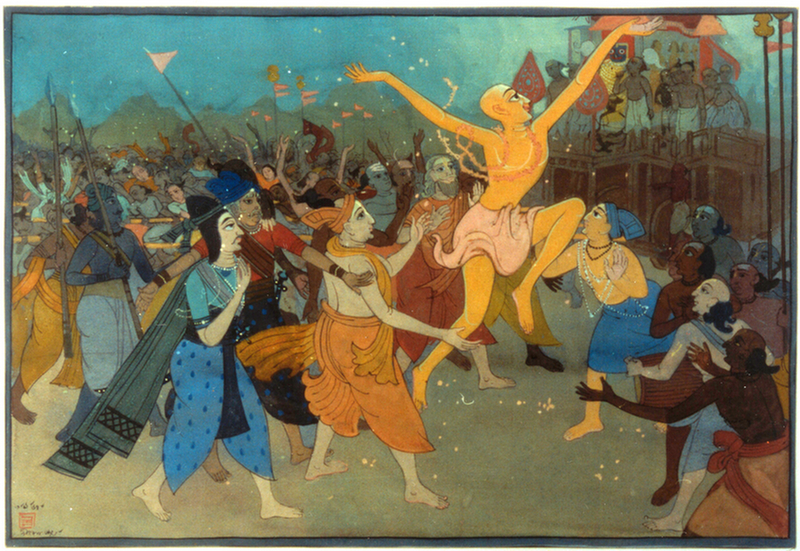
“The first mandate that He issued to Prabhu Nityananda and Haridasa was this: ‘Go, friends, go through the streets of the town, meet every man at his door and ask him to sing the name of Hari with a holy life, and you then come and report to Me every evening the result of your preaching.’ Thus ordered, the two preachers went on and met Jagai and Madhai, two most abominable characters. They insulted the preachers on hearing Mahaprabhu’s mandate, but were soon converted by the influence of ‘bhakti’ (devotion) inculcated by their Lord. The people of Nadia were now surprised. They said, ‘Nimai Pandita is not only a gigantic genius, but He is certainly a missionary from God Almighty.’ From this time to His twenty-third year, Mahaprabhu preached His principles not only in Nadia but in all important towns and villages around His city. In the houses of His followers He shewed miracles, taught the esoteric principles of ‘bhakti’ and sang His ‘sankirtan’ with other bhaktas. His followers of the town of Nadia commenced to sing the holy name of Hari in the streets and bazaars. This created a sensation and roused different feelings in different quarters. The ‘bhaktas’ were highly pleased.
The ‘smarta brahmanas’ became jealous of Nimai Pandita’s success and complained to Chand Kazi against the character of Caitanya as un-Hindu. The Kazi came to Srivasa Pandita’s house and broke a ‘mrdanga’ (‘khola’ drum) there and declared that unless Nimai Pandit ceased to make noise about His queer religion he would be obliged to enforce Mohammedanism on Him and His followers. This was brought to Mahaprabhu’s notice. He ordered the townspeople to appear in the evening each with a torch in his hand. This they did, and Nimai marched out with His ‘sankirtan’ divided in 14 groups, and on His arrival in the Kazi’s house, He held a long conversation with the Kazi and in the end communicated into his heart His Vaisnava influence by touching his body. The Kazi then wept and admitted that he had felt a keen spiritual influence which had cleared up his doubts and produced in him a religious sentiment which gave him the highest ecstasy. The Kazi then joined the sankirtan party. The world was astonished at the spiritual power of the Great Lord, and hundreds and hundreds of heretics converted and joined the banner of Visvambhara after this affair. “It was after this that some of the jealous and low-minded ‘brahmanas’ of Kulia picked a quarrel with Mahaprabhu and collected a party to oppose Him.

Nimai Pandita was naturally a soft-hearted person, though strong in His principles. He declared that party feelings and sectarianism were the two great enemies of progress and that as long as He should continue to be an inhabitant of Nadia belonging to a certain family, His mission would not meet with complete success. He then resolved to be a citizen of the world by cutting His connection with His particular family, caste and creed, and with this resolution He embraced the position of a ‘sannyasi’ at Katwa, under the guidance of Keshava Bharati of that town, on the 24th year of His age. His mother and wife wept bitterly for His separation, but our hero, though soft in heart, was a strong person in principle. He left His little world in His house for the unlimited spiritual world of Krsna with man in general.
“After His ‘sannyasa’, He was induced to visit the house of Advaita Prabhu in Santipura. Advaita managed to invite all His friends and admirers from Nadia and brought Sacidevi to see her son. Both pleasure and pain invaded her heart when she saw her son in the attire of a ‘sannyasi’. As a ‘sannyasi’, Krsna Caitanya put on nothing but a ‘kaupina’ (two pieces of cloth, a loin cloth) and a ‘bahirvasa’ (outer covering). His head was without hair, and His hands bore a ‘danda’ (stick) and a ‘kamandalu’
(hermit’s water pot). The Holy Son fell at the feet of His beloved mother and said, “Mother! This body is yours, and I must obey your orders. Permit me to go to Vrndavana for My spiritual attainments.” The mother, in consultation with Advaita and others, asked her son to reside in Puri (the town of Jagannatha) so that she might obtain His information now and then. Mahaprabhu agreed to that proposition and in a few days left Santipura for Orissa.

His biographers have described the journey of Krsna Caitanya (that was the name He got after His ‘sannyasa’) from Santipura to Puri in great detail. He travelled along the side of the Bhagirathi as far as Chatrabhoga, situated now in Thana Mathurapura, Diamond Harbour, 24 Parganas. There He took a boat and went as far as Prayaga-ghata in the Midnapura District. Thence He walked through Balasore and Cuttack to Puri, seeing the temple of Bhuvanesvara on His way. Upon His arrival at Puri He saw Jagannatha in the temple and resided with Sarvabhauma at the request of the latter. Sarvabhauma was a gigantic ‘pandita’ of the day.
His readings knew no bounds. He was the best ‘naiyayika’ of the times and was known as the most erudite scholar in the Vedanta philosophy of the school of Sankaracarya. He was born in Nadia (Vidyanagara) and taught innumerable pupils in the ‘nyaya’ philosophy in his tola there. He had left for Puri some time before the birth of Nimai Pandita. His brother-in-law Gopinatha Misra introduced our new sannyasi to Sarvabhauma, who was astonished at His personal beauty and feared that it would be difficult for the young man to maintain ‘sannyasa-dharma’ during the long run of His life. Gopinatha, who had known Mahaprabhu from Nadia, had a great reverence for Him and declared that the ‘sannyasi’ was not a common human being. On this point Gopinatha and Sarvabhauma had a hot discussion. Sarvabhauma then requested Mahaprabhu to hear his recitation of the Vedanta-sutras, and the latter tacitly submitted. Caitanya heard with silence what the great Sarvabhauma uttered with gravity for seven days, at the end of which the latter said, ‘Krsna-Caitanya! I think You do not understand the Vedanta, for You do not say anything after hearing my recitation and explanations.’ The reply of Caitanya was that He understood the sutras very well, but He could not make out what Sankaracarya meant by his commentaries. Astonished as this, Sarvabhauma said, ‘How is it that you understand the meanings of the ‘sutras’ and do not understand the commentaries which explain the ‘sutras’? All well! If You understand the ‘sutras’, please let me have Your interpretations.’ Mahaprabhu thereon explained all the ‘sutras’ in His own way without touching the pantheistic commentary of Sankara.
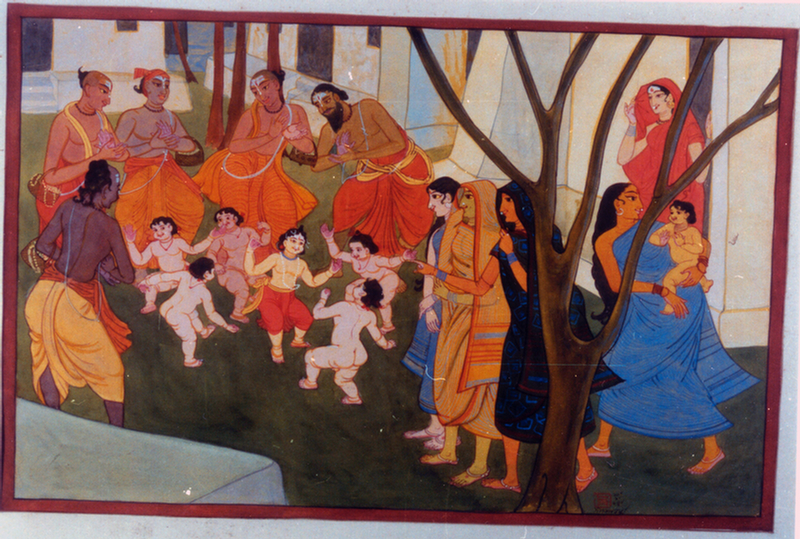
The keen understanding of Sarvabhauma saw the truth, beauty and harmony of arguments in the explanations given by Caitanya and obliged Him to utter that it was the first time that he had found one who could explain the Brahma-sutras in such a simple manner. He admitted also that the commentaries of Sankara never gave such natural explanations of the Vedanta-sutras as he had obtained from Mahaprabhu. He then submitted himself as an advocate and follower. In a few days Sarvabhauma turned out to be one of the best Vaisnavas of the time. When reports of this came out, the whole of Orissa sang the praise of Krsna Caitanya, and hundred and hundreds came to Him and became His followers. In the meantime Mahaprabhu thought of visiting Southern India, and He started with one Krsnadasa Brahmana for the journey.
“His biographers have given us a detail of the journey. He went first to Kurmaksetra, where He performed a miracle by curing a leper named Vasudeva. He met Ramananda Raya, the Governor of Vidyanagara, on the banks of the Godavari and had a philosophical conversation with him on the subject of ‘prema-bhakti’. He worked another miracle by touching (making them immediately disappear) the seven ‘tala-trees’ through which Ramacandra, the son of Dasaratha, had shot His arrow and killed the great Bali Raja. He preached Vaisnavism and ‘nama-sankirtana’ throughout the journey. At Rangaksetra He stayed for four months in the house of one Venkata Bhatta in order to spend the rainy season. There He converted the whole family of Venkata from Ramanuja Vaisnavism to Krsna-bhakti, along with the son of Venkata, a boy of ten years named Gopala, who afterwards came to Vrndavana and became one of the six Goswamis or prophets serving under their leader Sri Krsna Caitanya. Trained up in Sanskrit by his uncle Prabodhananda Sarasvati, Gopala wrote several books on Vaisnavism.
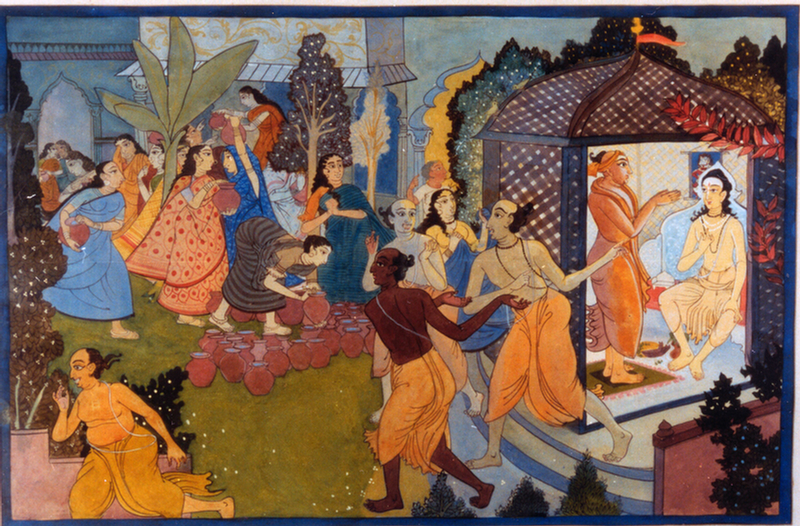
“Sri Caitanya visited numerous places in Southern India as far as Cape Comorin and returned to Puri in two years by Pandepura on the Bhima. In this latter place He spiritualized one Tukarama, who became from that time a religious preacher himself. This fact has been admitted in his ‘adhangas’, which have been collected in a volume by Mr. Satyendra Nath Tagore of the Bombay Civil Service. During His journey He had several discussions with the Buddhists, the Jains and the ‘mayavadis’ in several places and converted His opponents to Vaisnavism. “Upon His return to Puri, Raja Prataparudra-deva and several ‘pandita brahmanas’ joined the banner of Caitanya Mahaprabhu. He was now twenty-seven years of age. In His twenty-eighth year He went to Bengal as far as Gauda in Mald.
There He picked up two great personages named Rupa and Sanatana. Though descended from the lines of Karnatic brahmanas, these two brothers turned demi-Moslems by their continual contact with Hussain Shah, the then Emperor of Gauda. Their names had been changed by the Emperor into Dabir Khas and Sakara Mallik, and their master loved them heartily since they were both learned in Persian, Arabic and Sanskrit and were loyal servants of the state. The two gentlemen had found no way to come back as regular Hindus and had written to Mahaprabhu for spiritual help while He was at Puri. Mahaprabhu had written in reply that He would come to them and extricate them from their spiritual difficulties. Now that He had come to Gauda, both the brothers appeared before Him with their long-standing prayer. Mahaprabhu ordered them to go to Vrndavana and meet Him there.

“Caitanya returned to Puri through Santipura, where He again met His dear mother. After a short stay at Puri He left for Vrndavana. This time He was accompanied by one Balabhadra Bhattacarya. He visited Vrndavana and came down to Prayag (Allahabad), converting a large number of Mohammedans to Vaisnavism by argument from the Koran. The descendant of those converts are still known as Pathana Vaisnavas. Rupa Goswami met Him in Allahabad. Caitanya trained him up in spirituality in ten days and directed him to go to Vrndavana on missions. His first mission was to write theological works explaining scientifically pure ‘bhakti’ and ‘prema’. The second mission was to revive the places where Krsnacandra had in the end of ‘Dvapara-yuga’ exhibited His spiritual ‘lila’ (pastimes) for the benefit of the religious world. Rupa Goswami left Allahabad for Vrndavana, and Mahaprabhu came down to Benares.
There He resided in the house of Candrasekhara and accepted His daily ‘bhiksa’ (meal) in the house of Tapana Misra. Here it was that Sanatana Goswami joined him and took instruction for two months in spiritual matters. The biographers, especially Krsnadasa Kaviraja, have given us details of Caitanya’s teachings to Rupa and Sanatana. Krsnadasa was not a contemporary writer, but he gathered his information from the Goswamis themselves, the direct disciples of Mahaprabhu. Jiva Goswami, who was the nephew of Sanatana and Rupa and who has left us his invaluable work of Sat-sandarbha, has philosophized on the precept of his great leader. We have gathered and summarised the precepts of Caitanya from the books of those great writers.
“While at Benares, Caitanya had an interview with the learned ‘sannyasis’ of that town in the house of a Maratha ‘brahmana’ who had invited all the ‘sannyasis’ for entertainment. At this interview, Caitanya shewed a miracle which attracted all the ‘sannyasis’ to Him. Then ensued reciprocal conversation. The ‘sannyasis’ were headed by their most learned leader Prakasananda Sarasvati. After a short controversy, they submitted to Mahaprabhu and admitted that they had been misled by the commentaries of Sankaracarya. It was impossible even for learned scholars to oppose Caitanya for a long time, for there was some spell in Him which touched their hearts and made them weep for their spiritual improvement. The ‘sannyasis’ of Benares soon fell at the feet of Caitanya and asked for His grace (‘krpa’). Caitanya then preached pure ‘bhakti’ and instilled into their hearts spiritual love for Krsna which obliged them to give up sectarian feelings. The whole population of Benares, on this wonderful conversion of the ‘sannyasis’, turned Vaisnavas, and they made a master ‘sankirtana’ with their new Lord. After sending Sanatana to Vrndavana, Mahaprabhu went to Puri again through the jungles with His comrade Balabhadra. Balabhadra reported that Mahaprabhu had shown a good many miracles on His way to Puri, such as making tigers and elephants dance on hearing the name of Krsna.
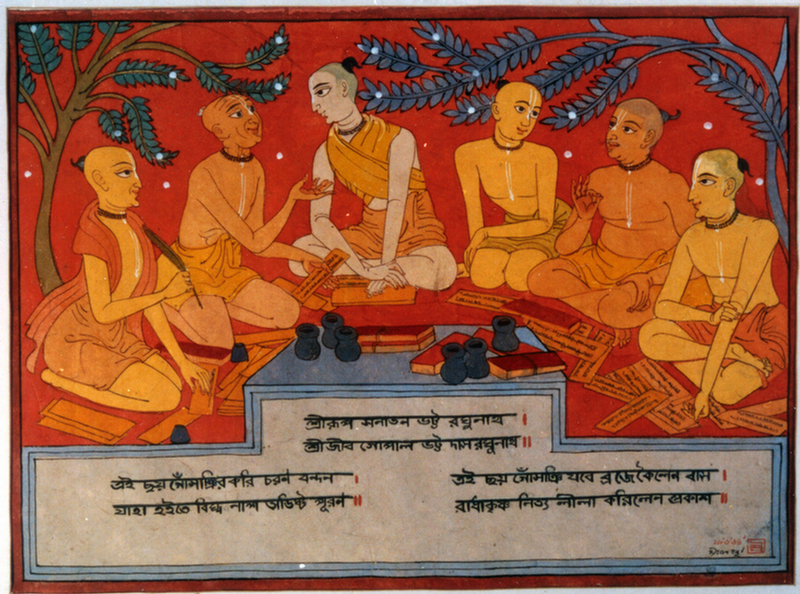
“From this time, that is, from His 31st year, Mahaprabhu continually lived in Puri the house of Kasi Misra until His disappearance in His forty-eighth year at the time of sankirtana in the temple of Tota-gopinatha. During these 18 years, His life was one of settled love and piety. He was surrounded by numerous followers, all of whom were of the highest order of Vaisnavas and who were distinguished from the common people by their purest character and learning, firm religious principles and spiritual love of Radha-Krsna. Svarupa Damodara, who had been known by the name of Purusottamacarya while Mahaprabhu was in Nadia, joined Him from Benares and accepted service as His secretary. No production of any poet or philosopher could be laid before Mahaprabhu unless Svarupa had passed it as pure and useful. Raya Ramananda was His second mate. Both he and Svarupa would sing while Mahaprabhu expressed His sentiments on a certain point of worship.
Paramananda Puri was His minister in matters of religion. There are hundreds of anecdotes described by His biographers which we do not think it meet here to reproduce. Mahaprabhu slept short. His sentiments carried Him far and wide in the firmament of spirituality every day and night, and all His admirers and followers watched Him throughout. He worshipped, communicated with His missionaries at Vrndavana, and conversed with those religious men who newly came to visit Him. He sang and danced, took no care of Himself and of-times lost Himself in religious beatitude. All who came to Him believed in Him as the all-beautiful God appearing in the nether world for the benefit of mankind. He loved His mother all along and sent her ‘mahaprasada’ now and then with those who went to Nadia. He was most amiable in nature. Humility was personified in Him. His sweet appearance gave cheer to all who came in contact with Him. He appointed Prabhu Nityananda as the missionary in charge of Bengal. He dispatched six disciples (Goswamis) to Vrndavana to preach love in the upcountry. This he markedly did in the case of Junior Haridasa. He never lacked in giving proper instructions in life to those who solicited them. This will be seen in His teachings to Raghunatha dasa Goswami. His treatment to Haridasa (senior) will show how He loved spiritual men and how He defied caste distinction in spiritual brotherhood.”(Thakura Bhaktivinoda.
20th August 1896.)

Sri Siksastakam
Sri Caitanya Mahaprabhu is the most recent incarnation of Krsna. He appeared
500 years ago in Bengal and in the form of Krsna’s devotee in the mood of Srimati Radharani. He left only 8 slokas (verses) of his instructions in writing, and they describe the glories of the Holy Names of the Lord and the mood one must have to chant and to be a devotee.
cheto-darpana-marjanam bhava-maha–davagni-nirvapanam shreyah-kairava-chandrika-vitaranam vidya-vadhu-jivanam anandambudhi-vardhanam prati-padam purnamritaswadanam sarvatma-snapanam param vijayate sri-krishna-sankirtanam
Glory to the Sri-Krsna-Sankirtana, which cleanses the heart of all the dust accumulated for years and extinguishes the fire of conditional life, of repeated birth and death. This sankirtana movement is the prime benediction for humanity at large because it spreads the rays of the benediction moon. It is the life of all transcendental knowledge. It increases the ocean of transcendental bliss, and it enables us to fully taste the nectar for which we are always anxious.
namnam akari bahudha nija-sarva-shaktis tatrarpita niyamitah smarane na kalah etadrishi tava kripa bhagavan mamapi durdaivam idrisham ihajani nanuragaha
O my Lord, Your holy name alone can render all benediction to living beings, and thus You have hundreds and millions of names, like Krsna and Govinda. In these transcendental names You have invested all Your transcendental energies. There are not even hard and fast rules for chanting these names. O my Lord, out of kindness You enable us to easily approach You by Your holy names, but I am so unfortunate that I have no attraction for them.
trinad api sunichena taror api sahishnuna amanina manadena kirtaniyah sada harih
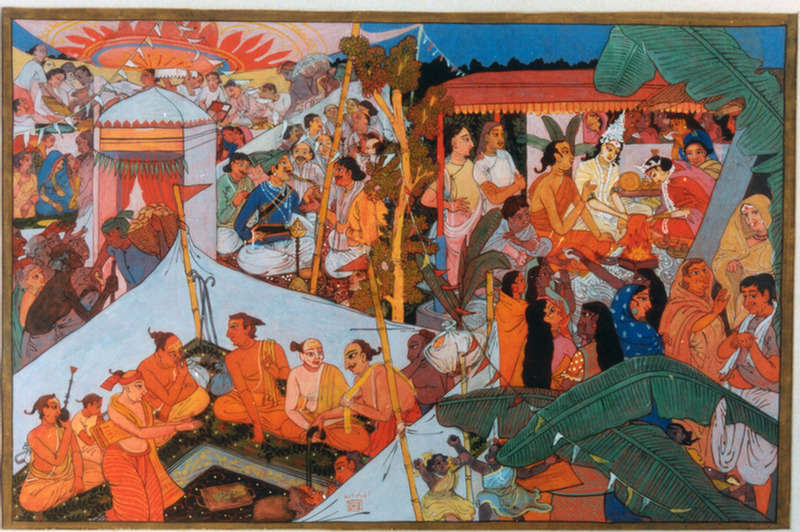
One should chant the holy name of the Lord in a humble state of mind, thinking oneself lower than the straw in the street; one should be more tolerant than a tree, devoid of all sense of false prestige, and should be ready to offer all respect to others. In such a state of mind one can chant the holy name of the Lord constantly.
na dhanam na janam na sundarim kavitam va jagad-isha kamaye mama janmani janmanishvare bhavatad bhaktir ahaituki twayi
O almighty Lord, I have no desire to accumulate wealth, nor do I desire beautiful women nor do I want any number of followers. I only want Your causeless devotional service, birth after birth.
ayi nanda-tanuja kinkaram patitam mam vishame bhavambudhau kripaya tava pada-pankaja- sthita-dhuli-sadrisham vichintaya
O son of Maharaja Nanda (Krsna), I am Your eternal servitor, yet somehow or other I have fallen into the ocean of birth and death. Please pick me up from this ocean of death and place me as one of the atoms at Your lotus feet.
nayanam galad-ashru-dharaya vadanam gadgada-ruddhaya gira pulakair nichitam vapuh kada tava nama-grahane bhavishyati
O my Lord, when will my eyes be decorated with tears of love flowing constantly when I chant Your holy name? When will my voice choke up, and when will the hairs of my body stand on end at the recitation of Your name?
yugayitam nimeshena chakshusha pravrishayitam shunyayitam jagat sarvam govinda-virahena me
O Govinda! Feeling Your separations I am considering a moment to be like twelve years or more. Tears are flowing from my eyes like torrents of rain, and I am feeling all vacant in the world in Your absence.
ashlishya va pada-ratam pinashtu mam adarshanan marma-hatam karotu va yatha tatha va vidadhatu lampato mat-prana-nathas tu sa eva naparah
I know no one but Krsna as my Lord, and He shall remain so even if He handles me roughly by His embrace or makes me brokenhearted by not being present before me. He is completely free to do anything and everything, for He is always my worshipful Lord, unconditionally.
All Glories to Sri Caitanya

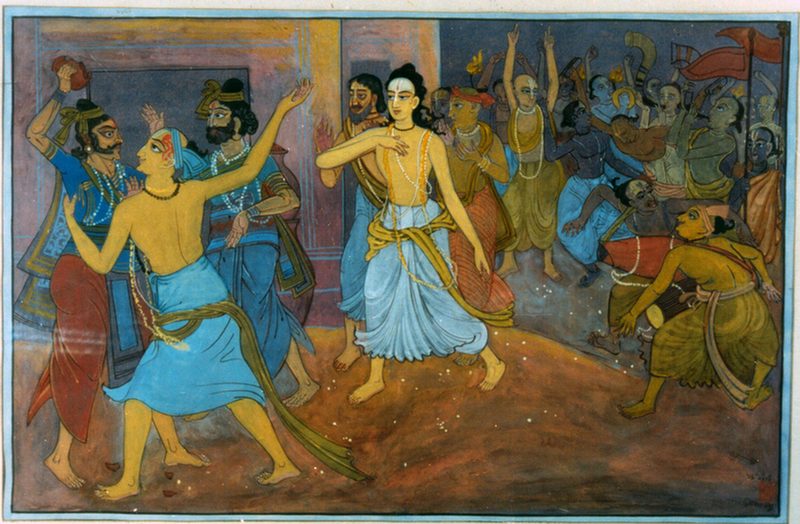
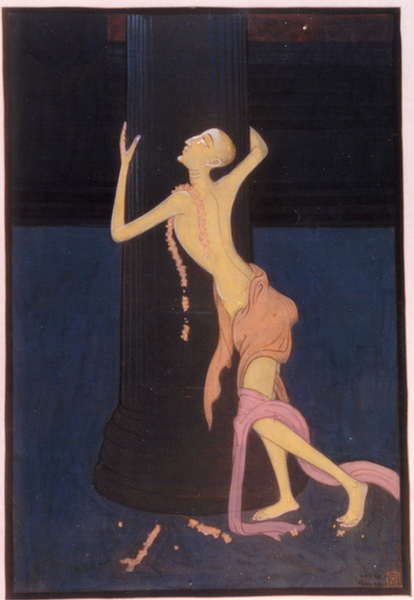


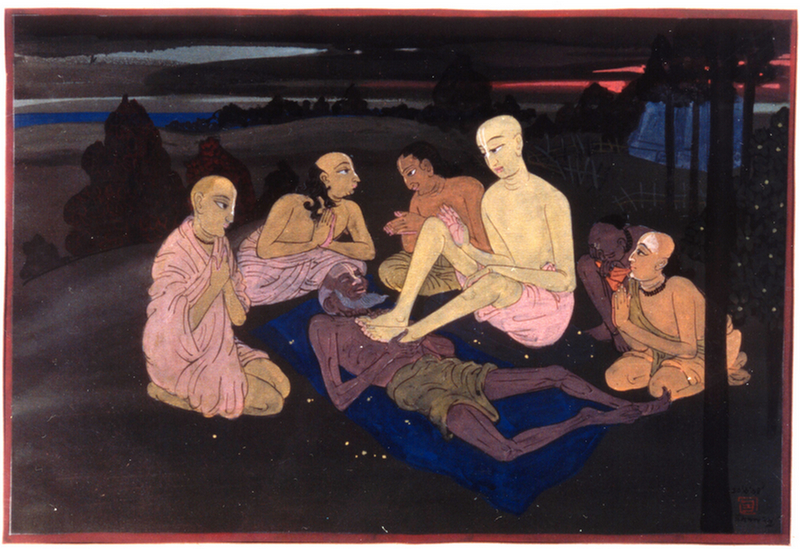
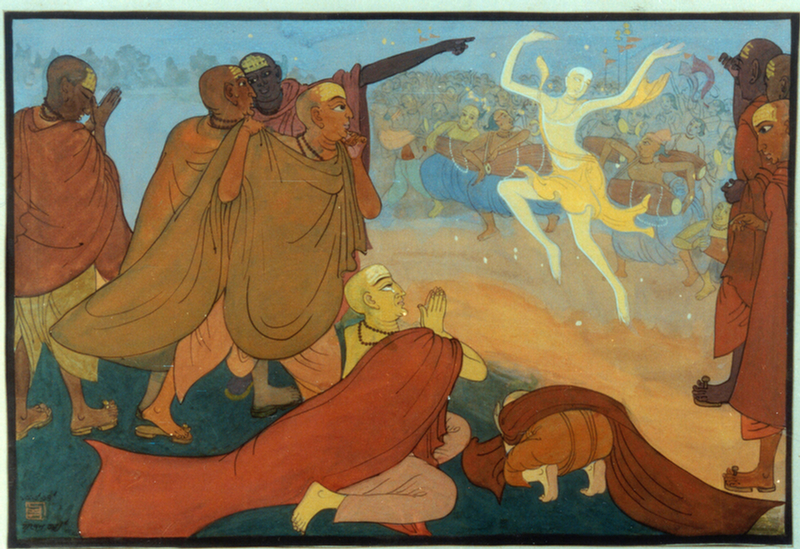
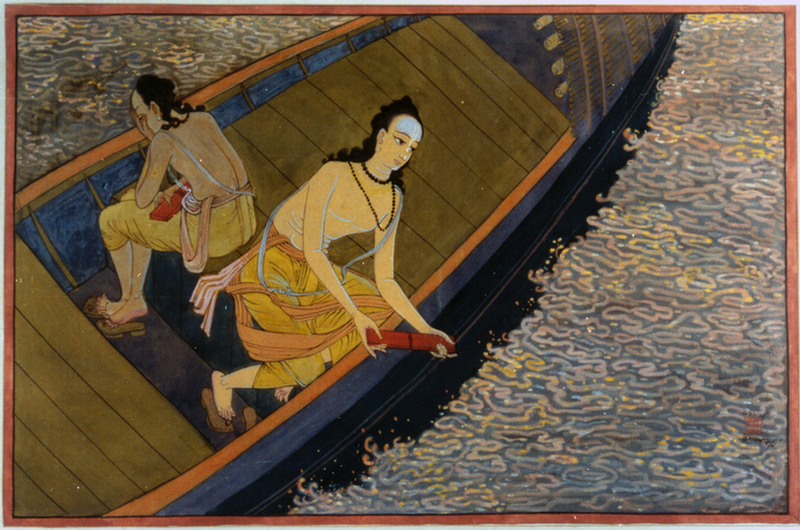
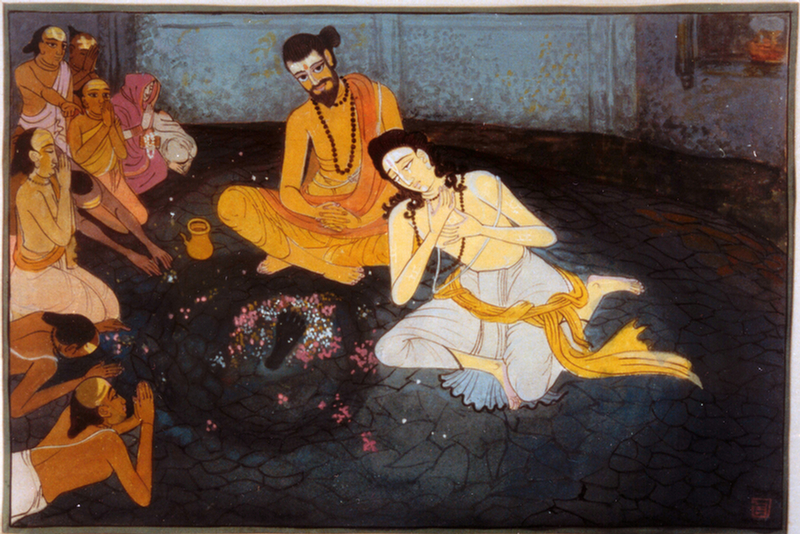
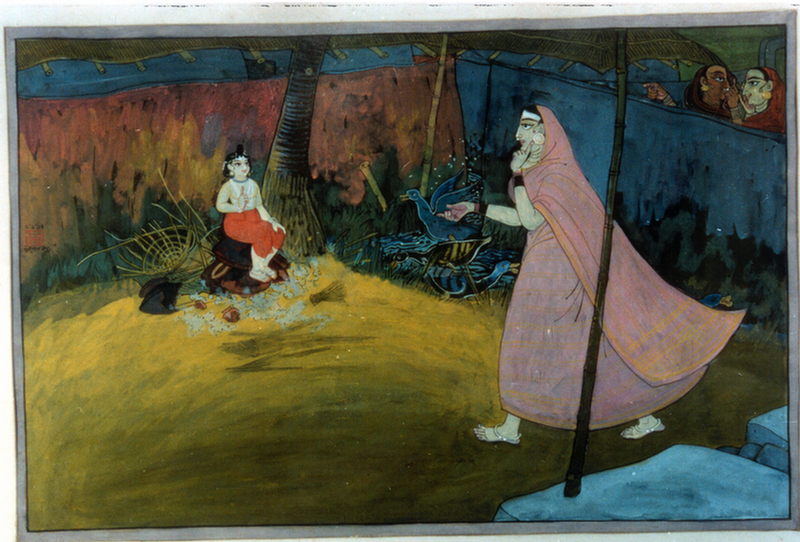
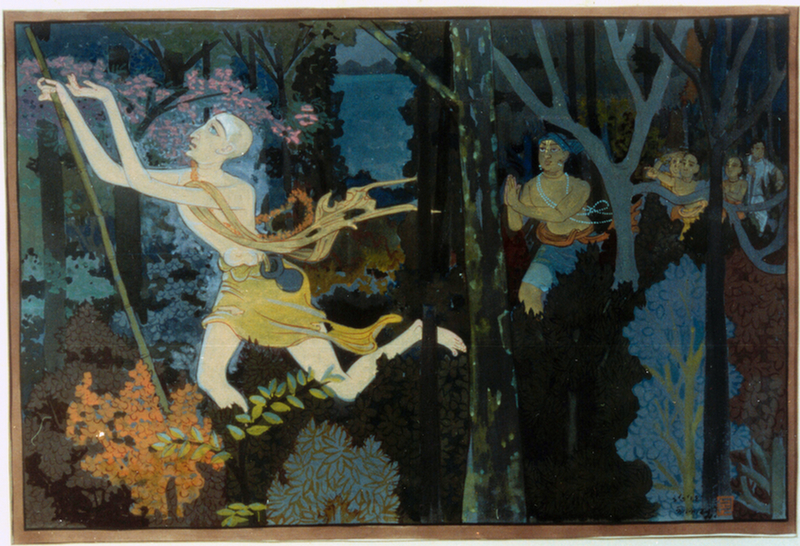
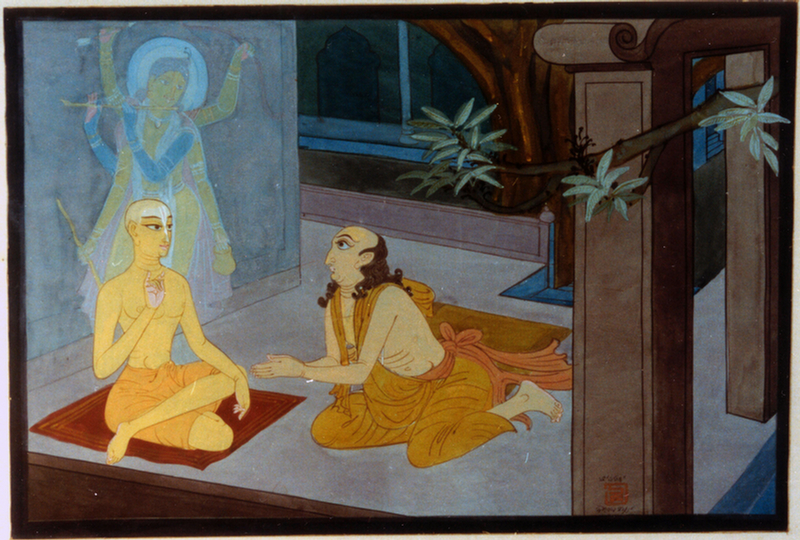
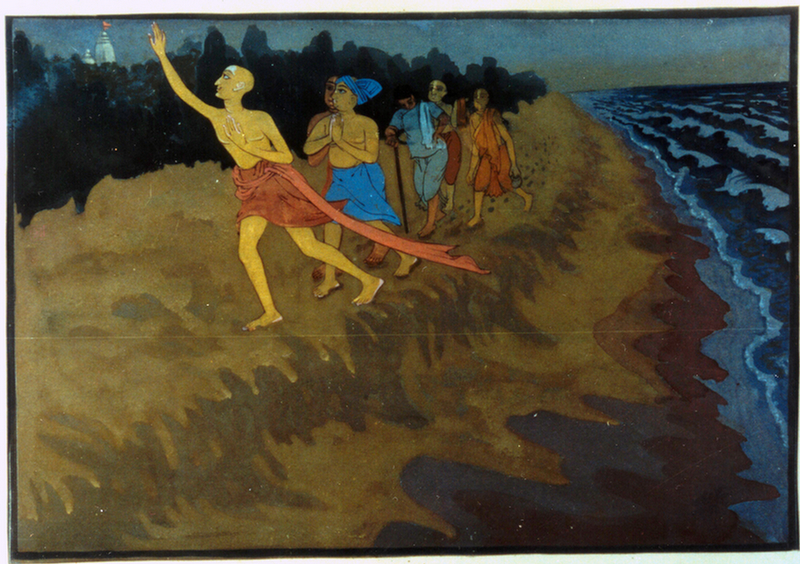
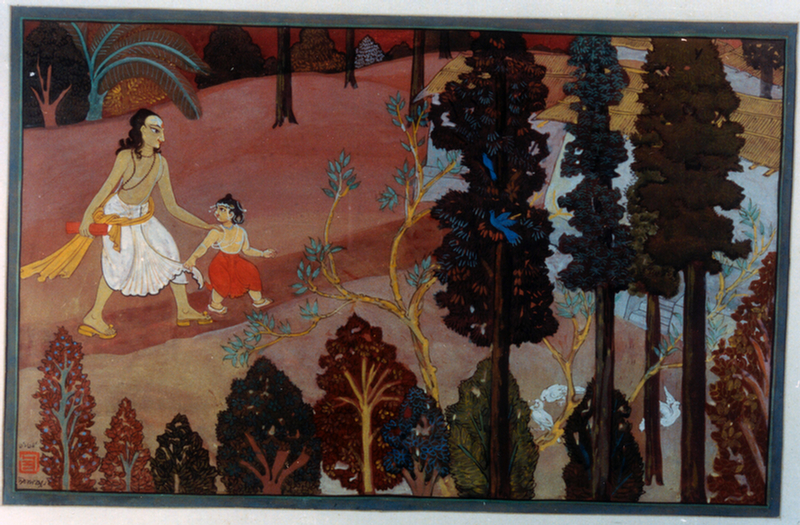

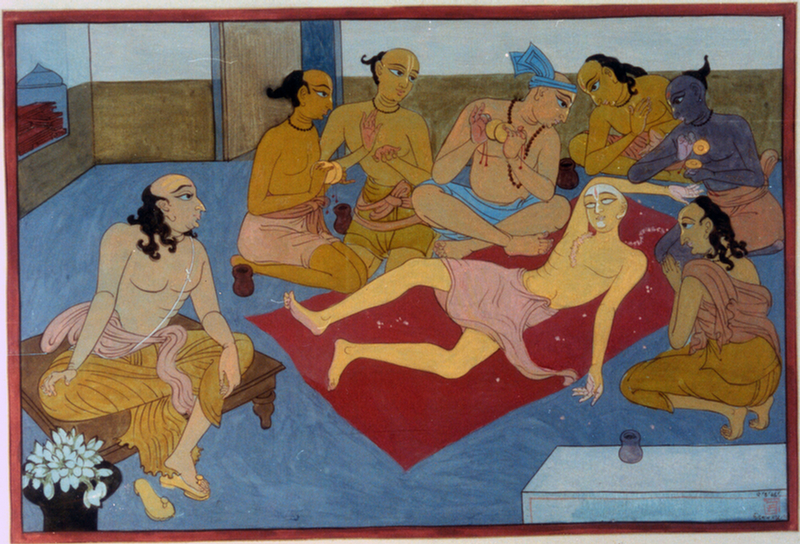

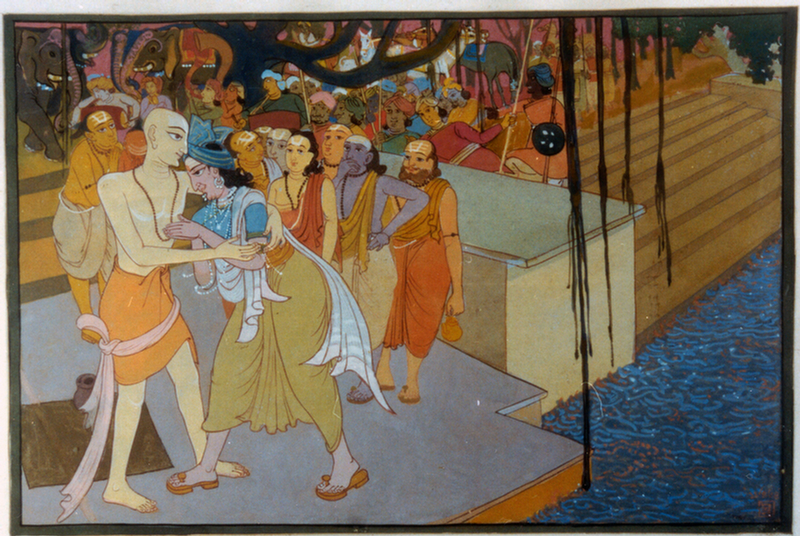
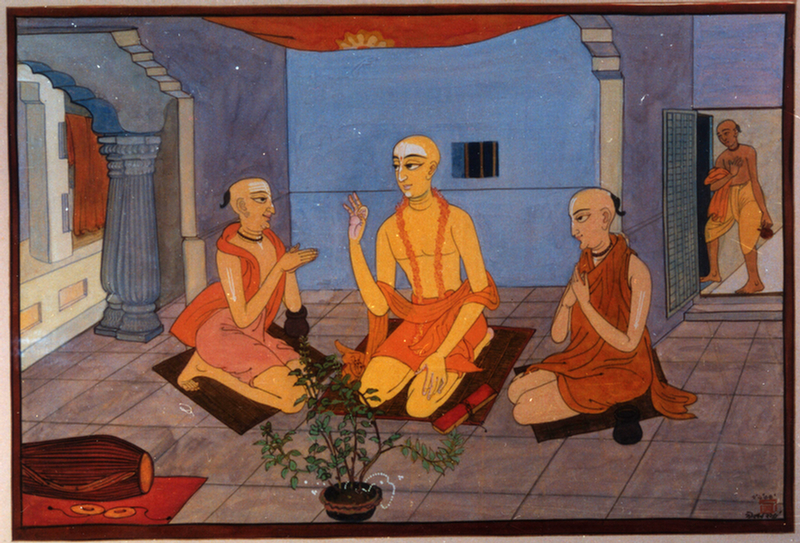

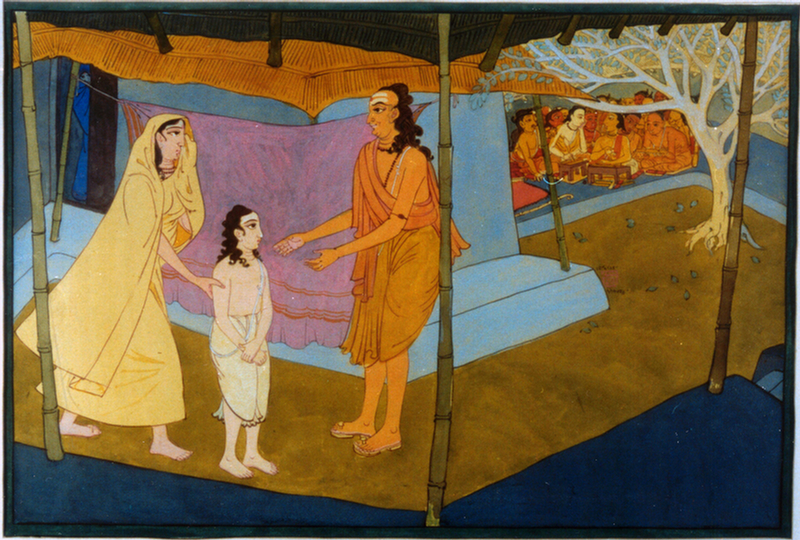
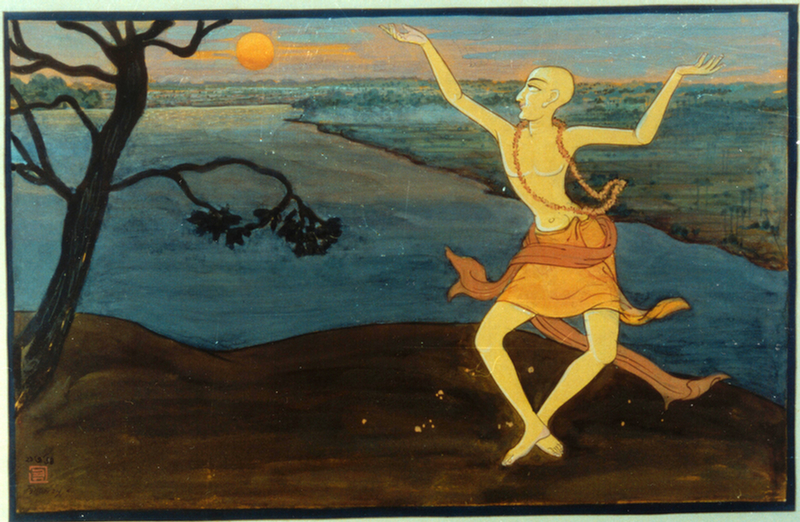
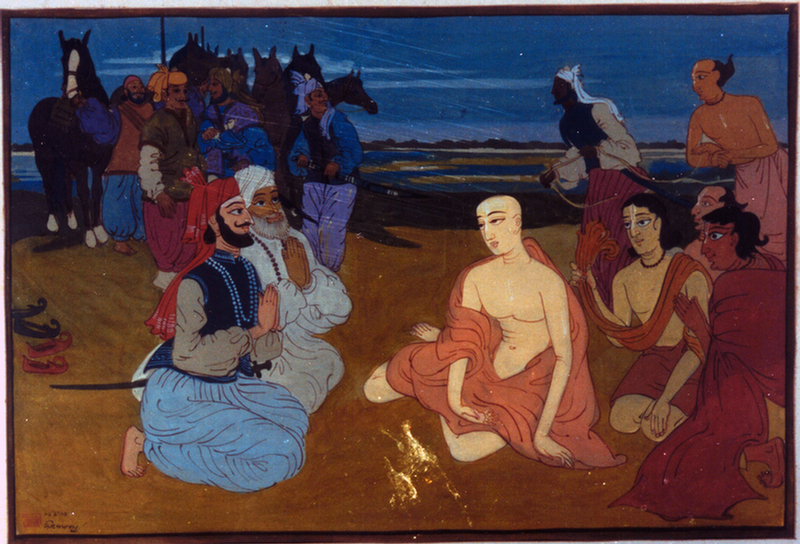
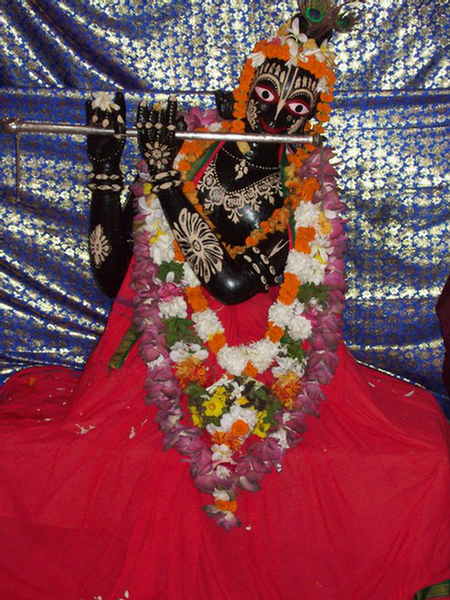
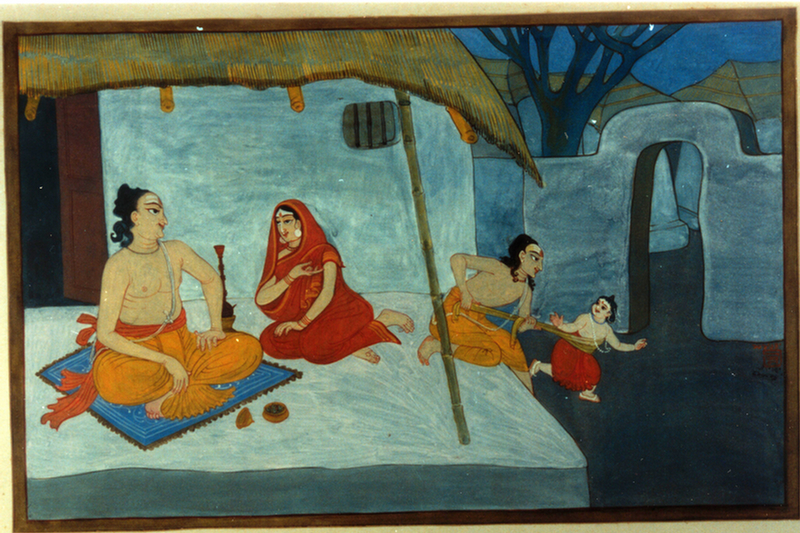
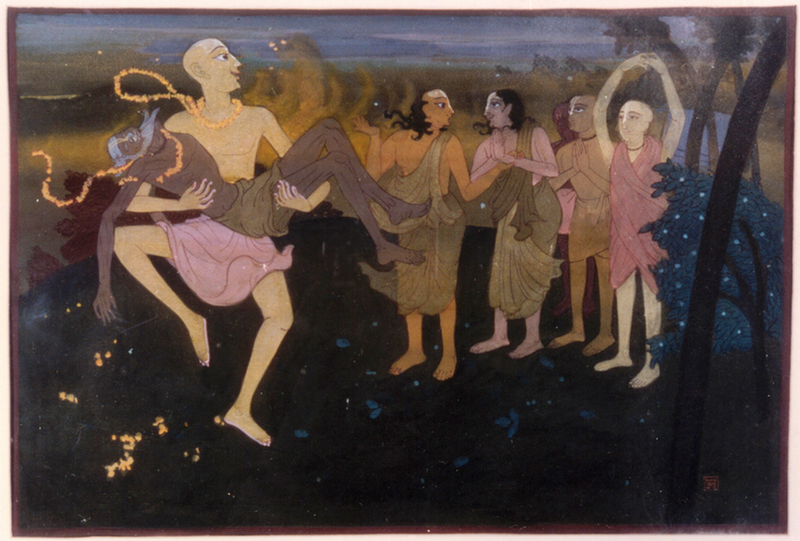
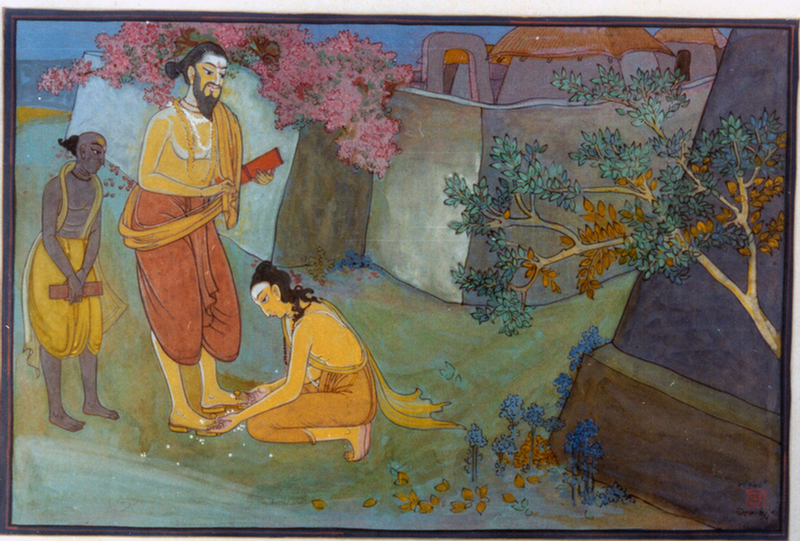
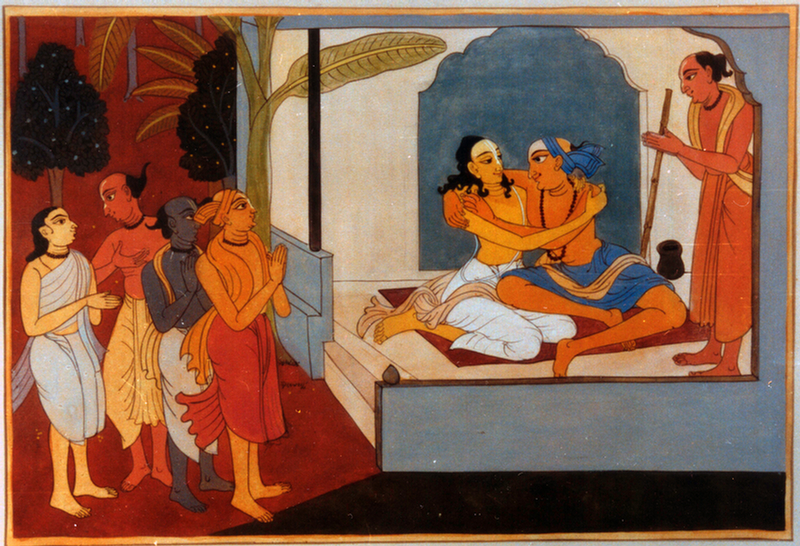

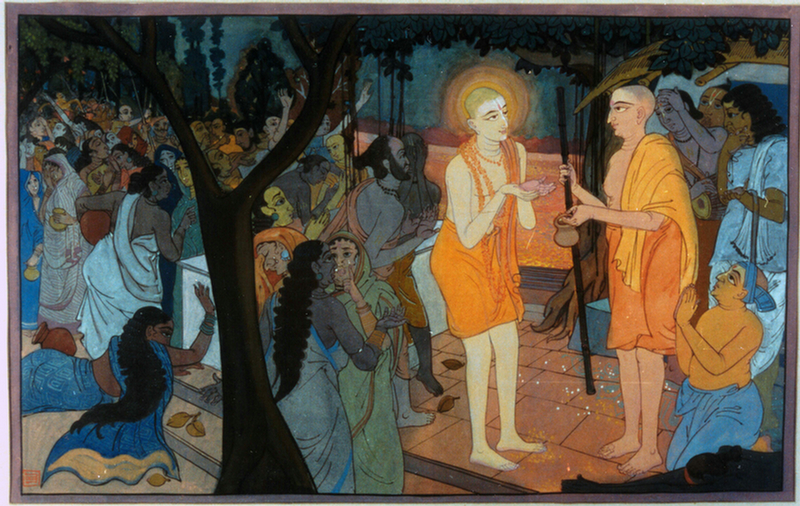

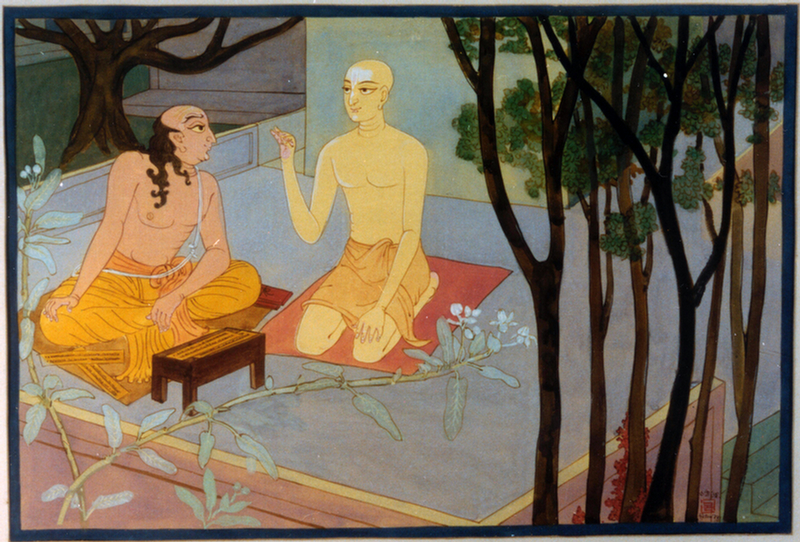
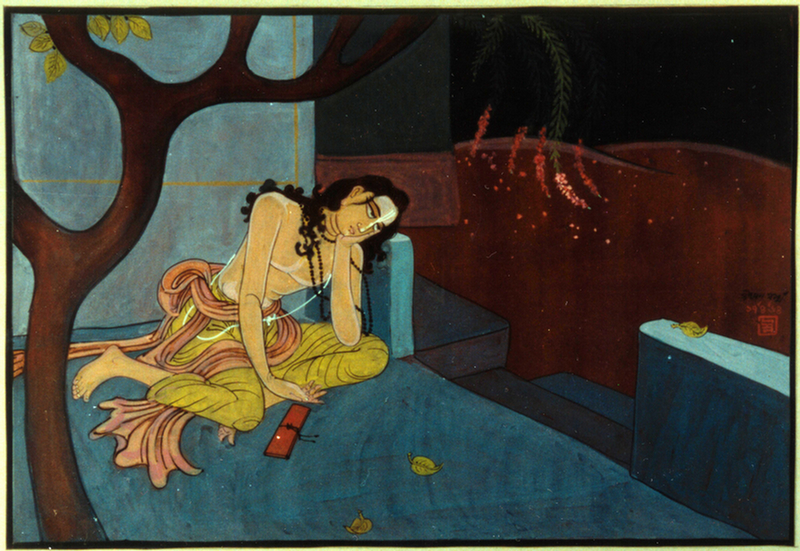
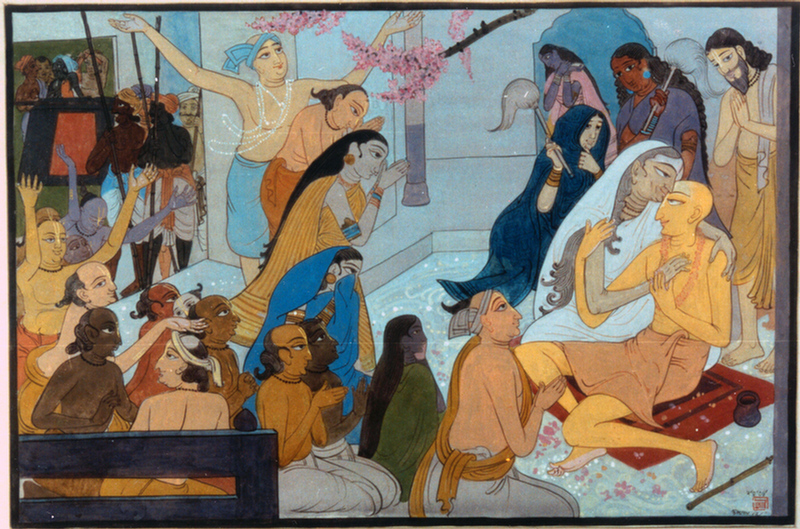
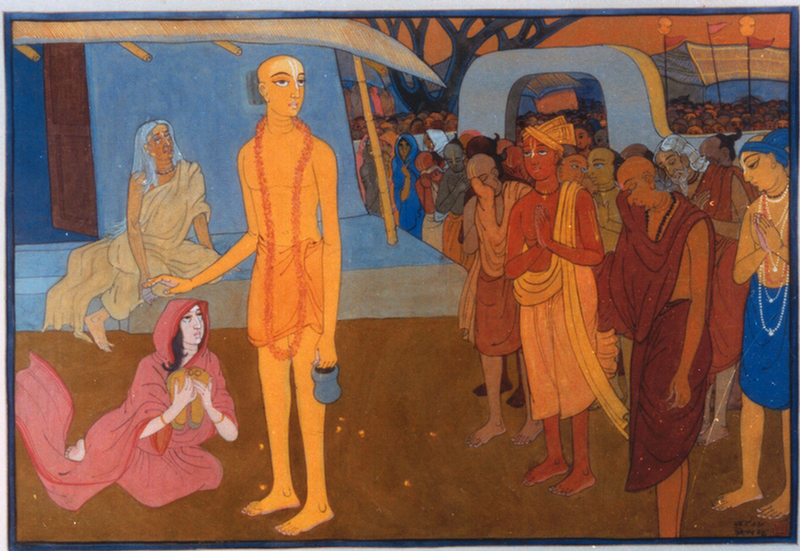
Source: http://www.dandavats.com/?p=8222
Comments